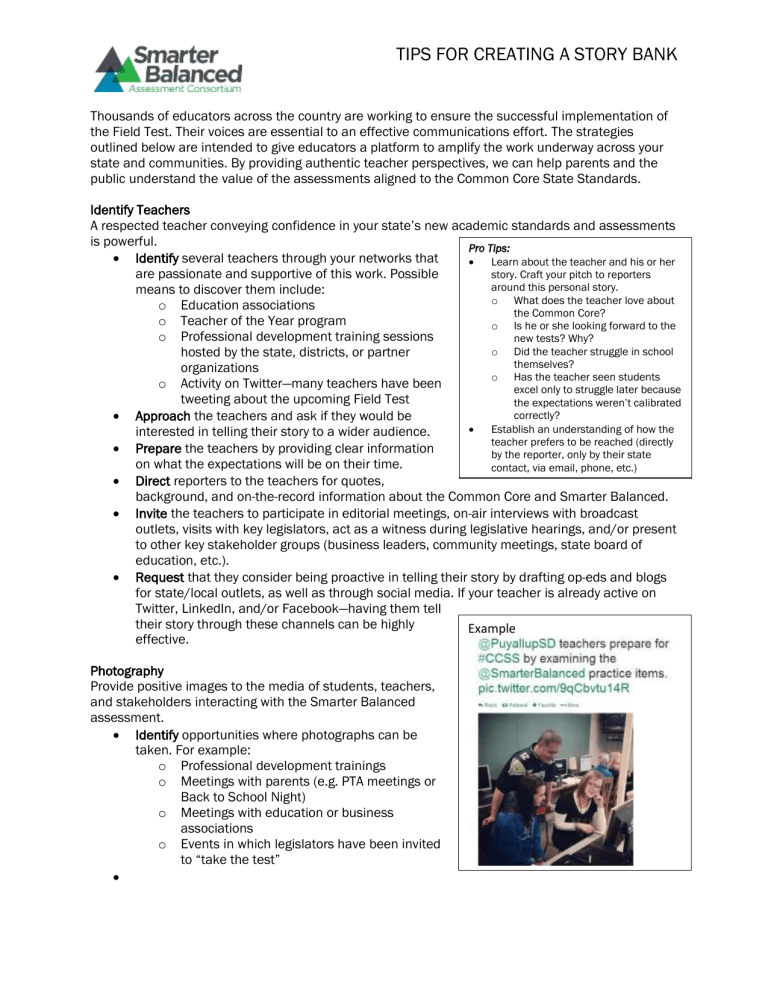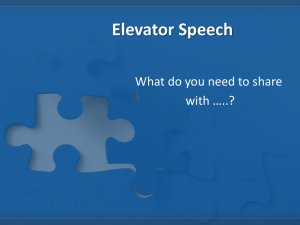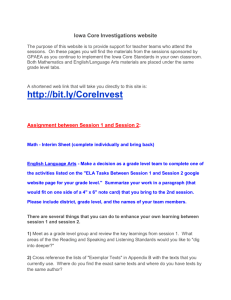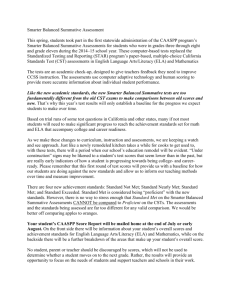Creating a Story Bank

TIPS FOR CREATING A STORY BANK
Thousands of educators across the country are working to ensure the successful implementation of the Field Test. Their voices are essential to an effective communications effort. The strategies outlined below are intended to give educators a platform to amplify the work underway across your state and communities. By providing authentic teacher perspectives, we can help parents and the public understand the value of the assessments aligned to the Common Core State Standards.
Identify Teachers
A respected teacher conveying confidence in your state’s new academic standards and assessments is powerful.
Identify several teachers through your networks that are passionate and supportive of this work. Possible
Pro Tips:
Learn about the teacher and his or her means to discover them include: o Teacher of the Year program o Professional development training sessions hosted by the state, districts, or partner story. Craft your pitch to reporters around this personal story. o What does the teacher love about o Education associations organizations the Common Core? o Is he or she looking forward to the new tests? Why? o Did the teacher struggle in school themselves? o Has the teacher seen students excel only to struggle later because o Activity on Twitter—many teachers have been tweeting about the upcoming Field Test
Approach the teachers and ask if they would be interested in telling their story to a wider audience.
Prepare the teachers by providing clear information on what the expectations will be on their time. the expectations weren’t calibrated correctly?
Establish an understanding of how the teacher prefers to be reached (directly by the reporter, only by their state contact, via email, phone, etc.)
Direct reporters to the teachers for quotes, background, and on-the-record information about the Common Core and Smarter Balanced.
Invite the teachers to participate in editorial meetings, on-air interviews with broadcast outlets, visits with key legislators, act as a witness during legislative hearings, and/or present to other key stakeholder groups (business leaders, community meetings, state board of education, etc.).
Request that they consider being proactive in telling their story by drafting op-eds and blogs for state/local outlets, as well as through social media. If your teacher is already active on
Twitter, LinkedIn, and/or Facebook—having them tell their story through these channels can be highly effective.
Example
Photography
Provide positive images to the media of students, teachers, and stakeholders interacting with the Smarter Balanced assessment.
Identify opportunities where photographs can be taken. For example: o Professional development trainings o Meetings with parents (e.g. PTA meetings or
Back to School Night) o Meetings with education or business associations o Events in which legislators have been invited to “take the test”
TIPS FOR CREATING A STORY BANK
Remember that big crowds are not always necessary to achieve big impact. Even a close-up shot of one teacher, student, or stakeholder on a computer can be supported by a caption that conveys your message.
Follow existing policy regarding student, parent, and teacher privacy prior to capturing or distributing images.
Distribute photographs on a schedule to help establish a routine and spread out the opportunities to convey your message. For example, you may capture 10 pictures at one event and distribute two of the photos each day for a week to maximize the impact of that single event. Given the wide reach of the Field Test, consider leveraging all of your distribution channels for this effort. It is better to risk over-communicating this work than communicating too little for fear of inundating stakeholders. Distribution channels include: o E-newsletter o Twitter o Facebook o Instagram o Pinterest o Direct emails/outreach to:
Key reporters and editors
State legislators and other key policymakers
Other stakeholders (business leaders, education organizations, parent organizations, etc.)
Video Diaries
Through authentic teacher voices, video diaries tell the story of standards and assessments.
Identify teachers interested in chronicling their experience administering the Field Test.
Provide clear instructions in your “ask” (see below).
Distribute the diaries through your website, e-newsletter, and/or social media platforms.
Notify the Smarter Balanced communications team in order to further amplify the story!
Example Instructions for Teachers:
Thank you for agreeing to record your story! We are dedicated to informing parents and the public about the great work of teachers across the state in implementing the <<INSERT NAME OF STATE STANDARDS>> and the new Smarter Balanced assessments. Part of that work is administering the practice run of the assessments—or
Field Test—which will help to ensure that the assessments are accurate and fair for all students. This practice run also gives teachers and schools a chance to practice test administration procedures, and students the opportunity to experience the new assessments. Smarter Balanced will use information from the Field Test to improve the assessments and plan for their roll-out.
These video diaries will be shared through the <<INSERT NAME OF STATE DEPARTMENT OF EDUCATION>> website, e-newsletter, and/or social media platforms.
How to record your diary:
Use the video capability on your smart phone—think of it as a video “selfie.”
Since we will be posting these videos online, please keep them short and to the point (less than two minutes is ideal). Think about the two or three key messages that you want to convey.
Questions to consider before recording your diary:
How will our new academic standards help students succeed?
How do the new assessments measure learning differently?
How did students react to the Field Test?
Where to post your diary once complete:
<<INSERT NAME OF STATE DEPARTMENT OF EDUCATION FILE SHARING SYSTEM>>





